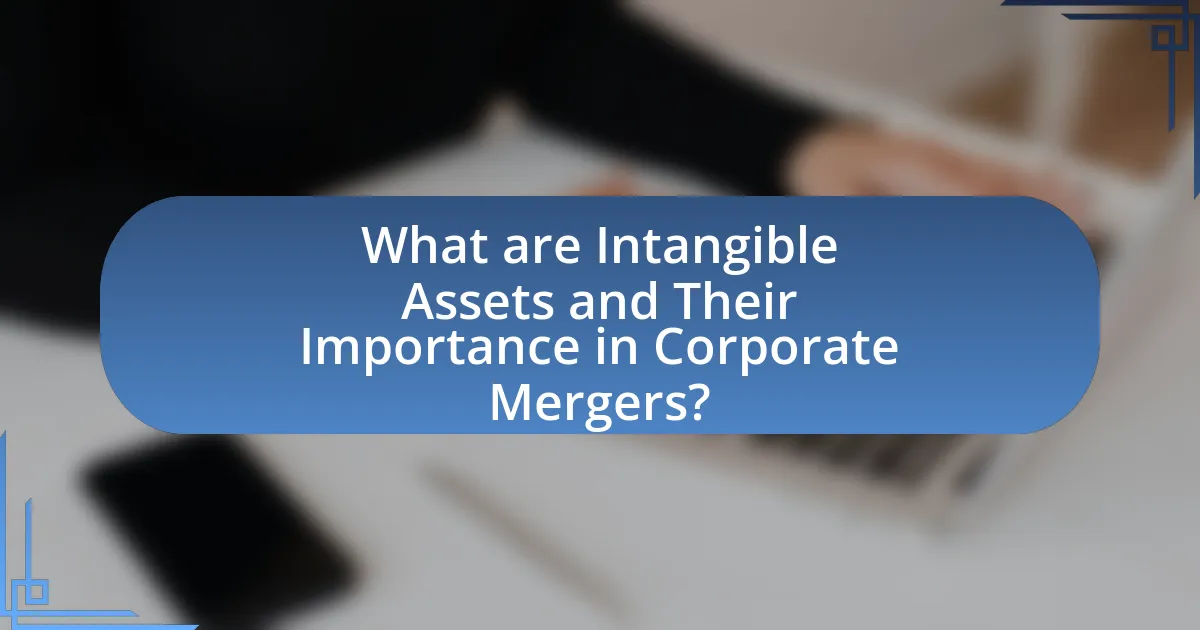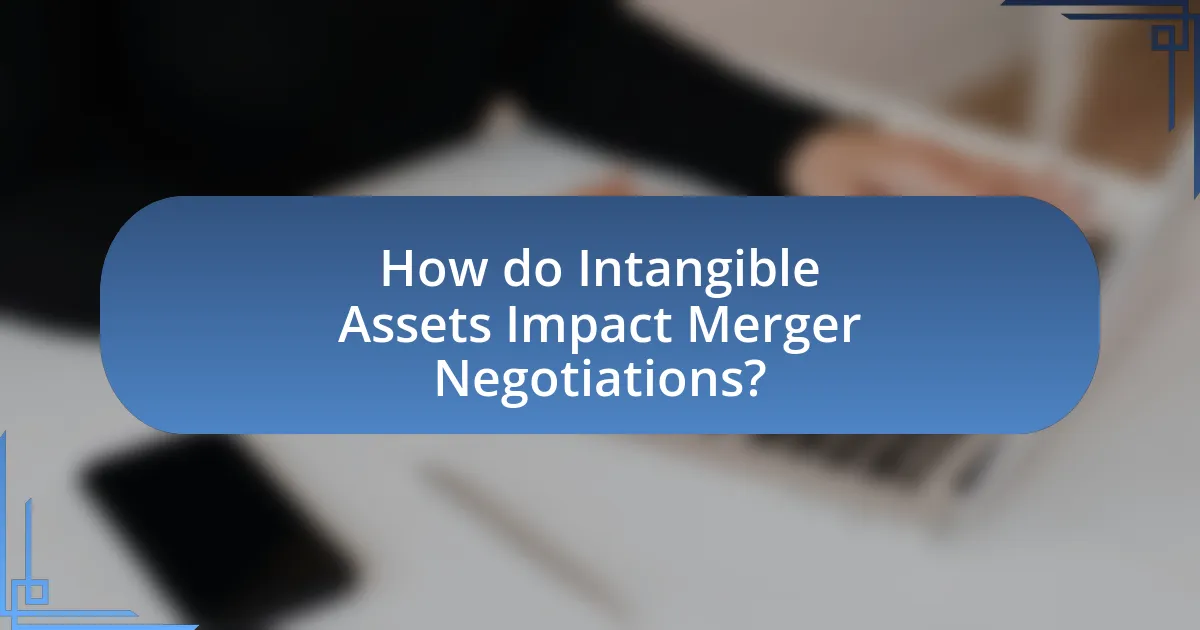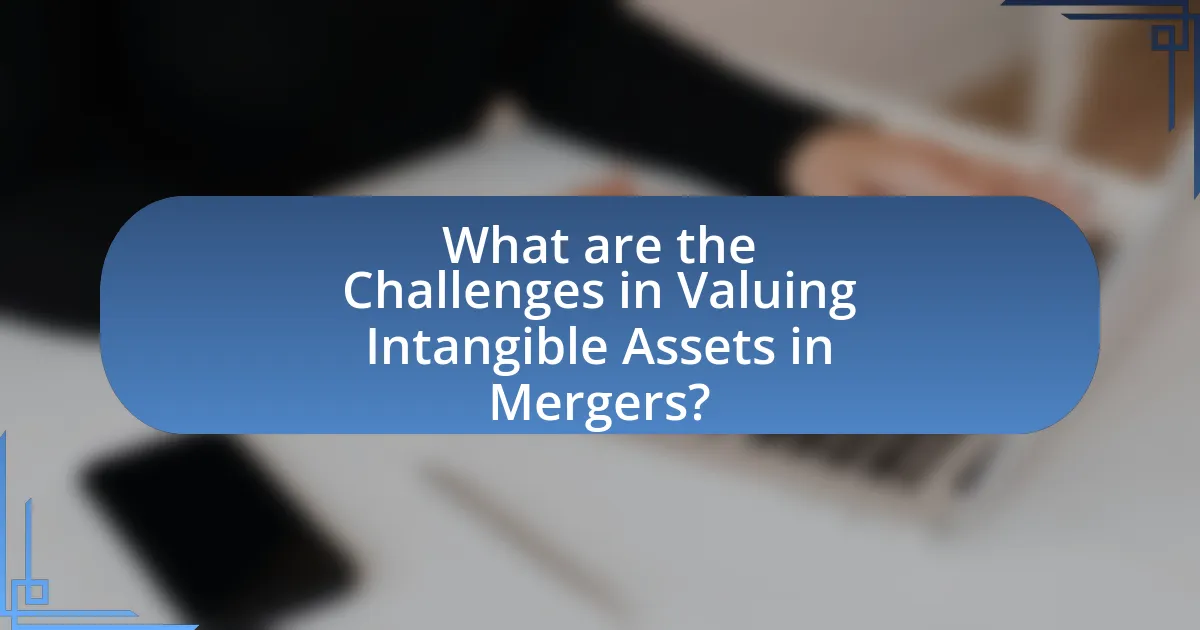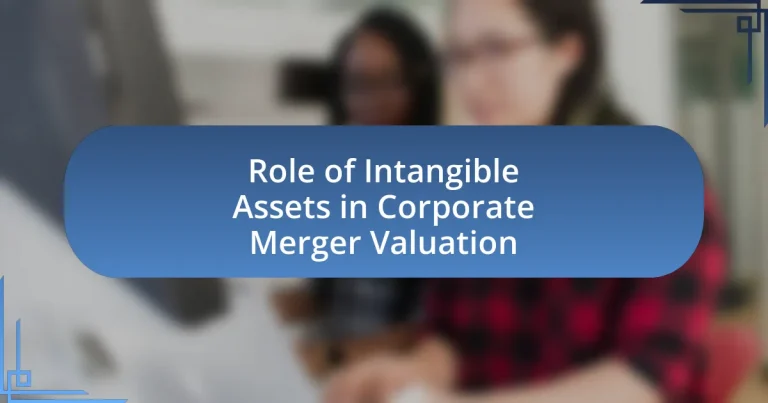Intangible assets, which include non-physical elements such as intellectual property, brand recognition, and customer relationships, play a crucial role in corporate merger valuation. These assets can account for a significant portion of a company’s market value, often up to 80% in certain industries, making their accurate assessment vital during mergers. The article explores the differences between intangible and tangible assets, the main types of intangible assets, and the challenges faced in their valuation. It also discusses how intangible assets influence merger negotiations, the methodologies used for their valuation, and best practices for managing these assets effectively in the context of mergers.

What are Intangible Assets and Their Importance in Corporate Mergers?
Intangible assets are non-physical assets that provide value to a company, such as intellectual property, brand recognition, customer relationships, and proprietary technology. Their importance in corporate mergers lies in their ability to significantly influence the valuation of a company, often accounting for a substantial portion of its overall worth. For instance, a study by the International Valuation Standards Council indicates that intangible assets can represent up to 80% of a company’s market value in certain industries, highlighting their critical role in determining the financial rationale behind mergers.
How do intangible assets differ from tangible assets?
Intangible assets differ from tangible assets primarily in their physical presence; intangible assets lack a physical form, while tangible assets are physical items. For example, intangible assets include intellectual property, brand recognition, and goodwill, which cannot be touched or measured in physical terms. In contrast, tangible assets encompass items like machinery, buildings, and inventory, which have a measurable physical existence. This distinction is crucial in corporate merger valuation, as intangible assets can significantly influence a company’s market value despite their non-physical nature.
What are the main types of intangible assets?
The main types of intangible assets include goodwill, trademarks, patents, copyrights, and trade secrets. Goodwill represents the excess value of a company over its identifiable net assets, often arising from brand reputation and customer relationships. Trademarks protect brand names and logos, while patents grant exclusive rights to inventions for a specified period. Copyrights safeguard original works of authorship, such as literature and art. Trade secrets encompass confidential business information that provides a competitive edge. These classifications are essential in corporate merger valuation, as they significantly influence the overall worth of a business.
Why are intangible assets often undervalued in mergers?
Intangible assets are often undervalued in mergers due to their inherent difficulty in quantification and lack of standardized valuation methods. Unlike tangible assets, which have clear market values and can be easily appraised, intangible assets such as brand reputation, intellectual property, and customer relationships do not have readily available metrics for valuation. This complexity leads to a reliance on subjective estimates, which can result in lower valuations. Additionally, many financial models prioritize short-term financial metrics over long-term strategic value, further contributing to the undervaluation of these assets during merger assessments.
What role do intangible assets play in corporate valuation during mergers?
Intangible assets significantly influence corporate valuation during mergers by contributing to the overall worth of a company beyond its physical assets. These assets, which include intellectual property, brand reputation, customer relationships, and proprietary technology, can account for a substantial portion of a company’s market value. For instance, a study by Ocean Tomo in 2015 indicated that intangible assets represented approximately 87% of the S&P 500’s market capitalization, highlighting their critical role in valuation. During mergers, the assessment of these intangible assets is essential for determining the fair value of the target company, as they often drive future revenue potential and competitive advantage. Therefore, accurately valuing intangible assets is crucial for achieving a successful merger outcome.
How do intangible assets influence the overall valuation process?
Intangible assets significantly influence the overall valuation process by contributing to a company’s competitive advantage and future earnings potential. These assets, which include intellectual property, brand reputation, and customer relationships, are often critical in determining a firm’s market value, especially in mergers and acquisitions. For instance, a study by the International Valuation Standards Council highlights that intangible assets can account for up to 80% of a company’s total value in certain industries, such as technology and pharmaceuticals. This substantial impact underscores the necessity of accurately assessing intangible assets during the valuation process to ensure a comprehensive understanding of a company’s worth.
What methodologies are used to assess the value of intangible assets?
The methodologies used to assess the value of intangible assets include the Income Approach, Market Approach, and Cost Approach. The Income Approach estimates the present value of future cash flows generated by the intangible asset, often utilizing discounted cash flow analysis. The Market Approach compares the intangible asset to similar assets that have been sold or licensed, providing a benchmark for valuation. The Cost Approach calculates the value based on the costs incurred to create or replace the intangible asset, considering factors such as development expenses and time. These methodologies are widely recognized in financial analysis and valuation practices, ensuring a comprehensive assessment of intangible assets in corporate merger valuation.

How do Intangible Assets Impact Merger Negotiations?
Intangible assets significantly influence merger negotiations by affecting the perceived value of a company. These assets, which include intellectual property, brand reputation, and customer relationships, can enhance a company’s market position and future earnings potential. For instance, a study by Deloitte found that companies with strong intangible assets often command higher premiums in acquisition deals, as these assets can lead to increased revenue streams and competitive advantages. Therefore, the presence and valuation of intangible assets are critical factors that shape negotiation strategies and outcomes in mergers.
What factors influence the negotiation of intangible asset value?
The negotiation of intangible asset value is influenced by several key factors, including market demand, the uniqueness of the asset, and the financial performance associated with the asset. Market demand affects how much buyers are willing to pay, as higher demand typically increases perceived value. The uniqueness of the intangible asset, such as proprietary technology or brand reputation, can significantly enhance its value, as these assets may provide competitive advantages. Additionally, the financial performance linked to the intangible asset, such as revenue generation or cost savings, serves as a critical metric in negotiations, with stronger financial indicators leading to higher valuations.
How can companies leverage intangible assets in negotiations?
Companies can leverage intangible assets in negotiations by highlighting their value to enhance perceived worth and justify higher valuations. Intangible assets, such as brand reputation, intellectual property, and customer relationships, can significantly influence negotiation outcomes. For instance, a strong brand can command premium pricing, while proprietary technology can provide competitive advantages. Research indicates that companies with robust intangible assets often achieve better negotiation positions, as these assets can lead to increased market share and profitability. Therefore, effectively communicating the strategic importance and financial impact of these intangible assets can strengthen a company’s negotiating stance.
What common pitfalls should companies avoid regarding intangible assets?
Companies should avoid overestimating the value of intangible assets, as this can lead to inflated merger valuations. Overvaluation often occurs when companies fail to conduct thorough due diligence or rely on optimistic projections rather than realistic assessments. For instance, a study by the International Valuation Standards Council highlights that improper valuation methods can result in significant financial discrepancies, impacting investment decisions and stakeholder trust. Additionally, neglecting to account for the potential obsolescence of intangible assets, such as patents or trademarks, can lead to future financial losses. Therefore, accurate valuation and ongoing assessment of intangible assets are crucial to avoid these pitfalls.
How do different industries value intangible assets in mergers?
Different industries value intangible assets in mergers based on their specific characteristics and the role these assets play in generating revenue. For instance, technology companies often emphasize intellectual property, such as patents and proprietary software, which can significantly enhance competitive advantage and market position. In contrast, consumer goods companies may focus on brand equity and customer loyalty, as these intangible assets directly influence consumer purchasing behavior and market share.
The valuation methods also vary; technology firms might use discounted cash flow models to project future earnings from innovations, while retail companies may apply market-based approaches, assessing comparable brand valuations. According to a study by the International Valuation Standards Council, intangible assets can account for up to 80% of a company’s total value in certain sectors, highlighting their critical importance in mergers across industries.
What industry-specific intangible assets are most commonly valued?
The most commonly valued industry-specific intangible assets include brand equity, patents, trademarks, customer relationships, and proprietary technology. Brand equity represents the value derived from consumer perception and loyalty, which can significantly impact a company’s market position. Patents provide exclusive rights to innovations, making them crucial in industries like pharmaceuticals and technology, where R&D investments are substantial. Trademarks protect brand identity, influencing consumer choice and brand recognition. Customer relationships, particularly in service-oriented sectors, are vital for retention and revenue generation. Proprietary technology, especially in tech and manufacturing, can offer competitive advantages and drive profitability. These assets are critical in corporate merger valuation as they contribute to the overall worth and future earnings potential of a company.
How does the valuation of intangible assets vary across sectors?
The valuation of intangible assets varies significantly across sectors due to differences in the nature and importance of these assets. For instance, technology and pharmaceutical sectors often assign higher values to intangible assets like patents, proprietary technologies, and brand equity, reflecting their critical role in competitive advantage and revenue generation. In contrast, sectors such as manufacturing may place less emphasis on intangible assets, focusing more on tangible assets like machinery and inventory. According to a study by the International Valuation Standards Council, the technology sector can attribute up to 80% of its market value to intangible assets, while traditional industries may attribute only 30% or less. This disparity highlights how sector-specific characteristics influence the assessment and significance of intangible assets in corporate merger valuation.

What are the Challenges in Valuing Intangible Assets in Mergers?
Valuing intangible assets in mergers presents several challenges, primarily due to their non-physical nature and the difficulty in quantifying their economic benefits. Intangible assets, such as brand equity, patents, and customer relationships, lack standardized valuation methods, making it hard to assess their true worth. Additionally, the subjective nature of these assets often leads to varying interpretations among stakeholders, complicating negotiations and financial reporting. For instance, a study by the International Valuation Standards Council highlights that over 80% of mergers fail to realize expected synergies, often due to misvaluation of intangible assets. This underscores the critical need for robust valuation frameworks that can accurately capture the potential of intangible assets in merger scenarios.
What are the main challenges faced in the valuation process?
The main challenges faced in the valuation process include accurately assessing intangible assets, determining appropriate valuation methods, and dealing with market volatility. Accurately assessing intangible assets, such as brand value or intellectual property, is difficult due to their subjective nature and lack of concrete metrics. Determining appropriate valuation methods is challenging because different methods can yield significantly different results, and selecting the wrong one can lead to misvaluation. Additionally, market volatility can impact the perceived value of assets, making it hard to establish a stable valuation. These challenges are critical as they can lead to significant financial discrepancies in corporate merger valuations.
How do market conditions affect the valuation of intangible assets?
Market conditions significantly influence the valuation of intangible assets by affecting investor perceptions, demand, and risk assessments. For instance, during economic downturns, the perceived risk associated with intangible assets, such as brand equity or intellectual property, typically increases, leading to lower valuations. Conversely, in a robust economic environment, heightened investor confidence can enhance the perceived value of these assets, resulting in higher valuations. Historical data from the 2008 financial crisis illustrates this phenomenon, where many companies saw their intangible asset valuations decline sharply due to market instability and reduced consumer spending. Thus, market conditions directly impact the financial metrics used to assess intangible assets, influencing merger and acquisition strategies.
What role does regulatory scrutiny play in the valuation of intangible assets?
Regulatory scrutiny significantly influences the valuation of intangible assets by ensuring compliance with accounting standards and legal requirements. This oversight affects how companies report and assess the value of their intangible assets, such as patents, trademarks, and goodwill. For instance, the Financial Accounting Standards Board (FASB) and the International Financial Reporting Standards (IFRS) set guidelines that require companies to evaluate the fair value of these assets, impacting merger and acquisition assessments. Regulatory bodies may also scrutinize the assumptions and methodologies used in these valuations, which can lead to adjustments in reported values and affect investor perceptions and market behavior.
What best practices can companies adopt for valuing intangible assets?
Companies can adopt several best practices for valuing intangible assets, including conducting thorough market research, utilizing appropriate valuation methods, and ensuring compliance with accounting standards. Conducting market research allows companies to understand the competitive landscape and identify the value of their intangible assets relative to industry benchmarks. Utilizing appropriate valuation methods, such as the income approach, market approach, or cost approach, ensures that the valuation reflects the true economic value of the intangible assets. Compliance with accounting standards, such as IFRS or GAAP, provides a framework for consistent and transparent reporting of intangible assets, which is crucial during corporate mergers. These practices enhance the accuracy and reliability of intangible asset valuations, ultimately supporting informed decision-making in merger scenarios.
How can companies ensure accurate valuation of intangible assets?
Companies can ensure accurate valuation of intangible assets by employing standardized valuation methods such as the income approach, market approach, and cost approach. The income approach estimates the present value of future cash flows generated by the intangible asset, while the market approach compares the asset to similar assets that have been sold in the market. The cost approach assesses the value based on the costs incurred to develop or acquire the asset.
Utilizing these methods allows companies to derive a more precise valuation by incorporating relevant financial data and market conditions. For instance, a study by the International Valuation Standards Council highlights that using multiple approaches can enhance the reliability of the valuation process, as it mitigates the risks associated with relying on a single method.
What tools and resources are available for valuing intangible assets?
Valuing intangible assets can be effectively accomplished using various tools and resources, including the Income Approach, Market Approach, and Cost Approach. The Income Approach estimates the present value of future cash flows attributable to the intangible asset, while the Market Approach compares the asset to similar assets that have been sold in the market. The Cost Approach assesses the value based on the costs incurred to create or replace the intangible asset. Additionally, resources such as the International Valuation Standards Council (IVSC) guidelines and the Financial Accounting Standards Board (FASB) standards provide frameworks and methodologies for accurate valuation. These tools and resources are widely recognized in the field of finance and accounting, ensuring that the valuation process adheres to established practices.
What are the key takeaways for effectively managing intangible assets in mergers?
Effectively managing intangible assets in mergers requires a strategic approach that includes thorough valuation, integration planning, and ongoing assessment. First, accurate valuation of intangible assets, such as brand equity and intellectual property, is crucial; studies show that up to 80% of a company’s value can be attributed to these assets. Second, developing a clear integration plan that addresses how to combine and leverage these assets can enhance synergies and drive growth post-merger. Finally, continuous monitoring and reassessment of intangible assets ensure that their value is maximized and aligned with the overall business strategy, as evidenced by research indicating that companies that actively manage their intangible assets post-merger achieve better financial performance.


